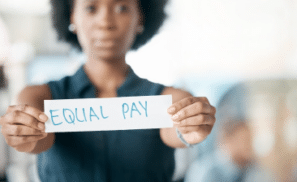June is the month in which the LGBTQ+ community and its allies come together to celebrate diversity, equality, and fight for the ongoing struggle for human rights – rights that are at risk and being actively targeted in 2023.
The challenges facing the LGBTQ+ community are numerous. Efforts to pass legislation restricting transgender rights, the rollback of protections for LGBTQ+ individuals, and debates on religious freedom versus anti-discrimination laws highlight the ongoing struggle for equality and acceptance. There are over 520 anti-LGBTQ+ bills introduced in state legislature in 2023, and over 220 bills specifically targeting transgender and non-binary people.
While the focus of Pride is primarily on LGBTQ+ rights, it’s impossible to miss the interconnectedness of various social justice movements. One of these connections lies between Pride Month and the fight for pay equity.
Let’s be honest: Getting pay right can be hard, and expressing the appropriate or even equitable amount of pride can feel the same. It’s undeniable, however, that advocating for fair pay across any industry aligns with the principles of inclusivity and equality.
June displays and amplifies the voices and experiences of LGBTQ+ individuals to advance equality and increase visibility. In addition to raising awareness around Pride Month, how can employers commit to, engage with, and celebrate the LGBTQ+ community? More specifically, what can HR and compensation professionals in particular do to show up for LGBTQ+ employees, not only during Pride Month, but all year long?
Here are three ways to support LGBTQ+ employees in your organization:
Create belonging
Diversity, Equity, Inclusion, and Belonging (DEIB) is an indispensable part of corporate ESG strategy in the modern era. Job candidates are increasingly assessing employers on how vocal and committed they are to DEIB — especially Generation Z. Diversity used to be emphasized the most, particularly during the recruitment process, but belonging is especially crucial for employee engagement.
Belonging in the workplace is the sense that an employee’s uniqueness is not only accepted but treasured by the organization and their colleagues. Belonging is assessed through the accumulation of day-to-day experiences that enables a person to feel safe bringing their whole, unique self to work.
Belonging for LGBTQ+ employees can be created by:
- Unconscious bias training: Proactively invest in programs to help build awareness and eliminate unconscious bias and discrimination in both hiring practices and managerial development.
- Spaces to congregate: Create safe spaces for LGBTQ+ employees such as dedicated Slack channels, monthly connections, and other forms of dedicated time together.
- Allyship: Provide active and continuous validation through day-to-day interactions and recognition programs as well as mentorship and sponsorship for LGBTQ+ employees and other underrepresented populations.
- Pride Month activities: Get into the spirit of Pride by granting employees time off to volunteer, or hosting or sponsoring events such as drag queen bingo, a history of LGBTQ+ in film, and anything else that is educational and inspirational.
- Public commitment to DEIB: Make sure you prominently feature your organization’s commitment to DEIB on your website and in the job application process with inclusion of LGBTQ+ allyship as a core aspect of your organization’s values.
Creating an inclusive and equitable workplace where employees feel like they belong is not only the right thing to do, but it also benefits business. When LGBTQ+ individuals are treated fairly, respected, and given equal opportunities, they thrive professionally, resulting in increased productivity and engagement with reduced turnover. By cultivating a diverse and inclusive workforce that both accepts and celebrates LGBTQ+ people, companies can tap into a broader talent pool and gain a competitive edge.
Address the wage gap
Equity is the foundation of a proper DEIB strategy. It encompasses not only pay equity, but also equity in visibility and opportunity. It’s important to note that equity is a shared responsibility. In the workplace, it requires awareness of underrepresentation and discrimination and support from compensation professionals, HR leaders, executive leadership, people managers, and teammates, just as in larger society equity requires support from allies, employers, lawmakers, and others to right wrongs and enact systemic change to maintain equity and justice for all.
And there are certainly wrongs to right. Studies have shown that LGBTQ+ individuals, especially those who identify as transgender or non-binary, face higher rates of unemployment, workplace discrimination, and wage gaps. Raising awareness around injustice is the essence of equity, as equity involves the understanding that some people need more than others due to either disadvantage or merit.
Pride Month serves as a platform to amplify the voices and experiences of LGBTQ+ individuals. However, even within the community, individuals face unique challenges when it comes to economic equality. Intersectionality plays a critical role in understanding how different aspects of a person’s identity, such as their gender, race, and sexual orientation, can compound the effects of discrimination and contribute to wage disparities.
Research has found that a wage gap exists for LGBTQ+ employees and widens for racial minorities, women, and people who identify as bisexual or transgender. The wage gap persists due to factors such as workplace bias, limited job opportunities, and lack of legal protections to counter discrimination. By acknowledging and addressing these disparities, we can work toward a more inclusive society where everyone is valued and compensated fairly.
LGBTQ+ Equal Pay Day is celebrated on June 15th in alignment with Pride Month to raise awareness of the LGBTQ+ pay gap. However, the LGBTQ+ pay gap is measured more infrequently and with more difficulty than the gender pay gap or racial pay gap given that information around gender identity and sexual orientation is not universally collected.
Fortunately, this is within the power of organizations to address. However, LGBTQ+ pay equity analysis requires organizations to ask employees about their sexual orientation in addition to other employee demographics data. This can be tricky to do without making employees feel anxious or singled out and, if attempted, needs to be accompanied with transparent communications about the purpose and intent of such questions as part of a larger DEIB strategy.
Employers can also close pay gaps by adopting pay transparency. Pay transparency has been shown to close the gender pay gap and it is reasonable to assume that it would also close LGBTQ+ pay gaps. Pay transparency closes pay gaps because it energizes organizations to invest in compensation strategy and pay equity and — most critically — to remediate pay inequities in order to publish pay ranges with confidence.
Pay transparency also closes pay gaps by providing employees and job candidates with information about which jobs earn higher pay, which can encourage underrepresented individuals to apply for jobs they might have otherwise overlooked. Publishing pay ranges also provides applicants with context for the position, which can help underrepresented groups negotiate with more confidence.
Recent pay transparency legislation, enhanced pay equity reporting requirements, and anti-discrimination laws are putting pressure on organizations to advance toward more equitable workplaces. The passing of this legislation will hopefully result in pay gaps closing for all underrepresented groups, including LGBTQ+ employees, will set the standard for how to achieve equal pay for countries all over the world.
Organizations that have not yet embarked on pay transparency or are just starting to look into pay equity analysis may be interested to know that investment in both of these areas in rapidly increasing. According to Payscale’s Compensation Best Practices Report, 63 percent of organizations say that pay equity is either a current or planned initiative at their organization in 2023, which has shot up considerably since before COVID-19. In addition, the percentage of organizations that are publishing pay ranges to job descriptions — whether required to by law or preemptively — has doubled compared to last year. Although only 14 percent of organizations say they analyze pay equity for LGBTQ+ today, this is likely to increase overtime.
Learn more about pay equity and pay transparency solutions from Payscale.
Celebrate progress
There have been significant strides made in advancing LGBTQ+ rights that are worth celebrating. Anti-discrimination legislation has been passed all over the world and 23 countries have legalized same-sex marriage. We have also seen a rapid increase in the visibility and representation of LGBTQ+ people in media, government, other public institutions, and the corporate sector.
Pride Month serves as a reminder of the immense progress made and the milestones achieved while also highlighting areas where improvement is still needed. By recognizing the intersection between Pride Month and fair pay, we can foster a deeper understanding of the challenges faced by LGBTQ+ individuals in the workforce, and work to enact lasting change.
As we strive for a more inclusive and equitable society, advocating for fair pay for everyone becomes an integral part of our collective efforts. By first raising awareness and outlining small steps corporations can take, such as pay equity analysis, there can be impactful action to bridge the gaps and create a workplace where everyone is treated with dignity and respect, compensated equitably for their contributions, and celebrated for who they are.

















